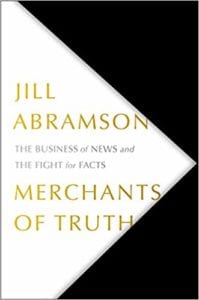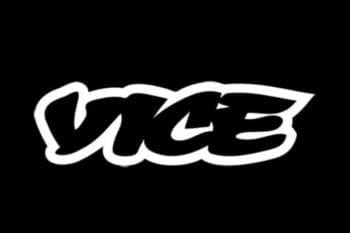Former NY Times Editor Faces Plagiarism Allegations

There was pretty much inevitable that Jill Abramson’s new book was going to ruffle some feathers.
Entitled Merchants of Truth: Inside the News Revolution, the book takes a deep dive into the last decade of journalism, following both established institutions and upstarts as they struggle to adapt to the modern news landscape.
As such, the book delves into journalistic ethics, bias and the business of journalism itself. In short, it was never going to be a wholly flattering book.
However, few expected that, when the book came out, that it would find itself embroiled in allegations of not just being factually inaccurate, but also that it contained plagiarized passages.
Abramson, a former executive editor for the New York Times, has denied the allegations and said that many of them are spurred by employees at VICE who are unhappy with how the book covered them.
Still, the allegations have definitely taken off, leaping from Twitter to get major media coverage, including the BBC, CNN and New York Magazine just to name a few.
However, not everyone is convinced. Several have come forward to defend Abramson and Abramson herself has said that she “endeavored to accurately and properly give attribution to the hundreds of sources that were part of my research.”
This raises a series of simple questions. What is happening? Why is such a prominent figure in journalism facing such allegations and why are those allegations at least somewhat divisive.
To answer that, we have to first understand the story so far.
The Jill Abramson Plagiarism Scandal So Far

The story of the scandal actual goes back to January, before the book was published. Vice, one of the news organizations covered in the book, received a galley copy of it and noticed several glaring errors.
The most notable of the errors was incorrectly describing a reporter as “transgender”. That error was fixed in the final version of the book.
After the book was released, VICE reporter Michael Moynihan reviewed the chapters in the final book and said that they were “clotted with mistakes”. However, he also said that, during his research of the three chapters focused on VICE, he also noticed plagiarized passages.
He then tweeted out several examples of paragraphs and sentences that bore extremely close resemblances to previously published works.
The story then grew larger as another reporter and author, Ian Frisch, also accused Abramson of plagiarism, this time of his work.
In all of the cases, the sources were cited in the book’s extensive footnotes. However, journalists and readers alike took issue with the extreme similarity with much of the text. Though none of the passages cited were 100% verbatim, they were so close in both content, order and word choice that independent creation seemed improbable to impossible.
While most people agreed with the accusers that this is plagiarism, at least a few rose to defend her, including Christopher Sprigman, a law professor at NYU. (H/T to @lippard for alerting me to this thread.)
As for Abramson herself, she initially blamed much of the attacks on her book as simple being VICE reporters that were unhappy with how they were portrayed in the book.
However, shortly thereafter, she said that she will “review the passages in question.”
Simon & Schuster, the book’s publisher, has released a statement saying that the book is “exhaustively researched and meticulously sourced” but that if any corrections are deemed necessary “we stand ready to work with the author in making those revisions.”
And that is where this story more or less ends. After a whirlwind few hours, the debate over Abramson’s book rages on. However, both the author and the publisher are standing by the work with promises to look further into the allegations and make changes later.
Meanwhile, the book is racking up one star reviews on Amazon with users pointing out the allegations of plagiarism and inaccuracies.
But is it plagiarism? That’s one of the more thorny questions to address because, as with most things plagiarism-related, the truth is not cut and dry.
Is It Plagiarism?
With matters of plagiarism like this, there’s often not a cut and dry answer. It is often perfectly possible for two reasonable people to look at the same set of facts and come up with different conclusions.
That being said, there are a few facts that are more or less indisputable:
- There are many passages in Abramson’s book that, while not verbatim, are close enough to the source that independent creation is virtually impossible.
- While the sources are cited in the footnotes, there is no indication that language was used, only the facts and information.
- This occurs at least a dozen times that we know about, and likely many more instances are waiting to be found in the book.
To those who study plagiarism, this is likely a familiar pattern. It’s one where the author either attempts to paraphrase by editing copy/pasted text or where they simply read their sources too closely when writing and end up taking too much of the original language.
Either way, it is very poor writing and certainly not how someone of Abramson’s prestige should be assembling her book. However, the question of whether it’s plagiarism is thornier but it is clear that, whether she intended to or not, she took credit for writing and phrasing that was not her own.
Though Abramson’s defenders are correct that rewriting basic facts and information is pointless and copying short bits doesn’t always amount to plagiarism, many of the examples deal with significantly more than that. Many of the sentences that Abramson parroted had very unique and original phrasing/ordering that appeared in both places.
To be clear, this is something that can happen accidentally in writing. On occasion, when writing my 3 Count columns, I catch myself reusing too much of the original language and then rewriting sections to make sure that they are in my words. Avoiding this often requires diligence (along with cleanroom writing techniques) and mistakes can happen.
As such, if it were an incident or two in the book, it would be easily dismissed. However, we’re dealing with over a dozen and only a small portion of the book has been checked. This is simply too much to ignore.
While I don’t see evidence at this time that Abramson maliciously and willfully plagiarized, especially given her penchant for footnotes, there’s no doubt in my view that this is plagiarism. However, it’s a plagiarism likely born of negligence, not intent.
This, unfortunately, doesn’t pair well with the other allegations of mistakes and errors in the book. Nor does it look well against an interview she gave New York Magazine where she discussed why she doesn’t record her sources. That interview caused an immediate backlash from other journalists that were horrified at the practice.
The portrait of this book that comes out of these stories is not a flattering one, especially considering it’s a book that focuses heavily on journalism ethics and attempts to defend journalism against those that wish to malign it.
It’s an important book, but it seems to be one of the worst messengers imaginable for what it’s trying to say.
Bottom Line
To be clear, Abramson is a former executive editor of the New York Times. She is currently a lecturer at Harvard University.
This book was released by one of the largest book publishers in the United States. It had access to all of the editing and fact checking resources that could be available to it.
Though not an academic work, it is certainly being presented as a journalistic work and is marketing itself as an accurate and thorough retelling of events.
As such, this book deserves to be held to the highest standard on plagiarism and, when held to that standard, it fails. It may not be a malicious plagiarism and it may not even be a very severe one, but it is still a plagiarism we should not see out of this work.
Unfortunately for the book, the similar passages are not the only issue and there appears to be many doubts raised about the book’s veracity and completeness. While these are serious issues in any book, they become even more serious when the book is about journalism and trust in the news media.
Even if one thinks these are minor infractions, the stage they are happening on makes them that much more serious. That, in turn, makes these issues something that neither the publisher nor Abramson can or should ignore.
However, it seems likely that they may do exactly that.
Want to Reuse or Republish this Content?
If you want to feature this article in your site, classroom or elsewhere, just let us know! We usually grant permission within 24 hours.
